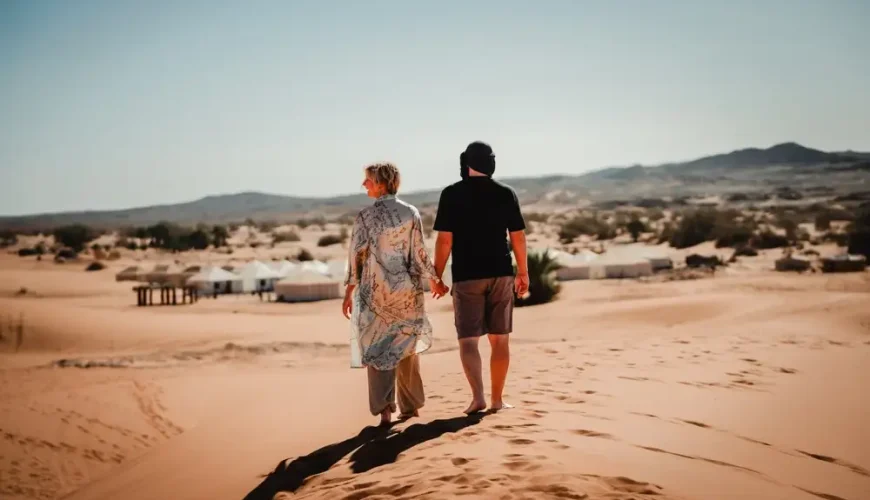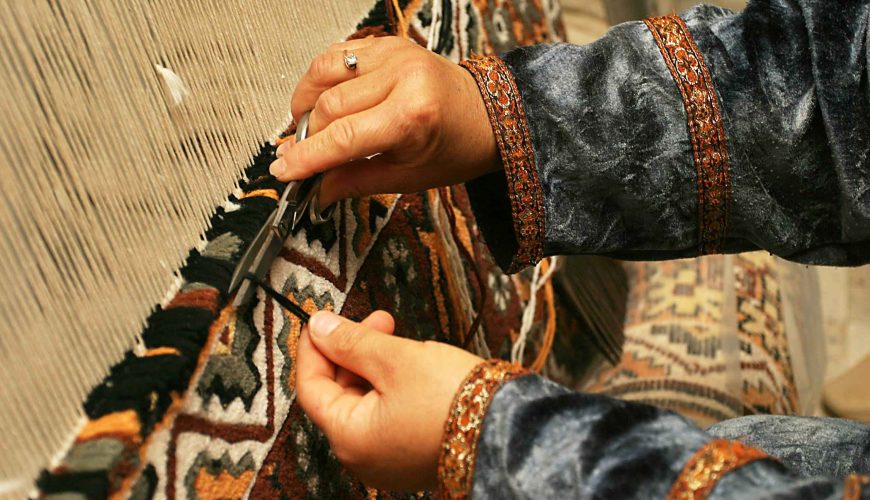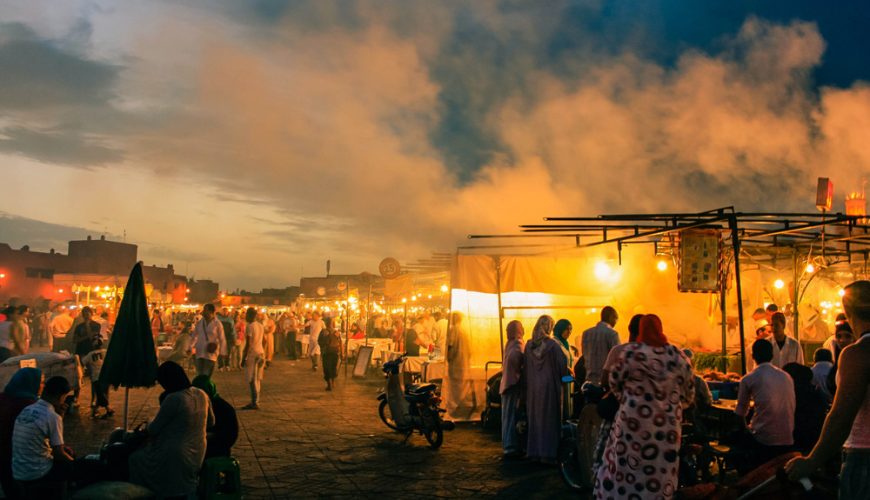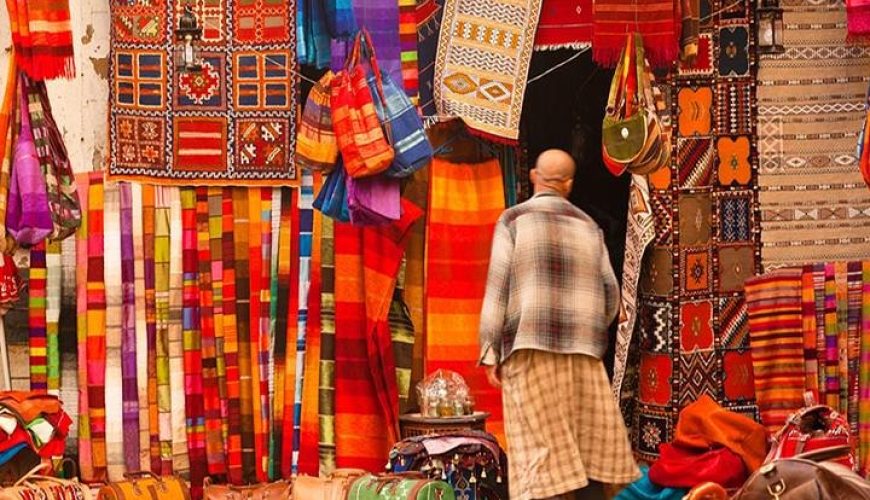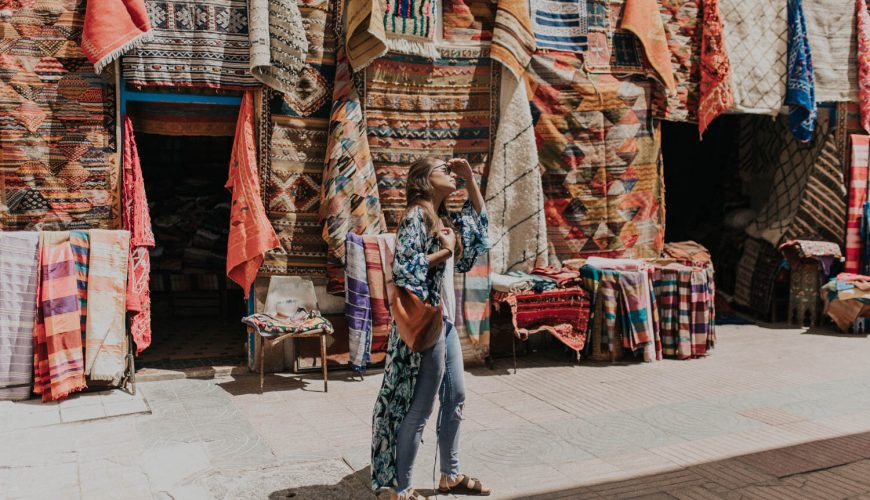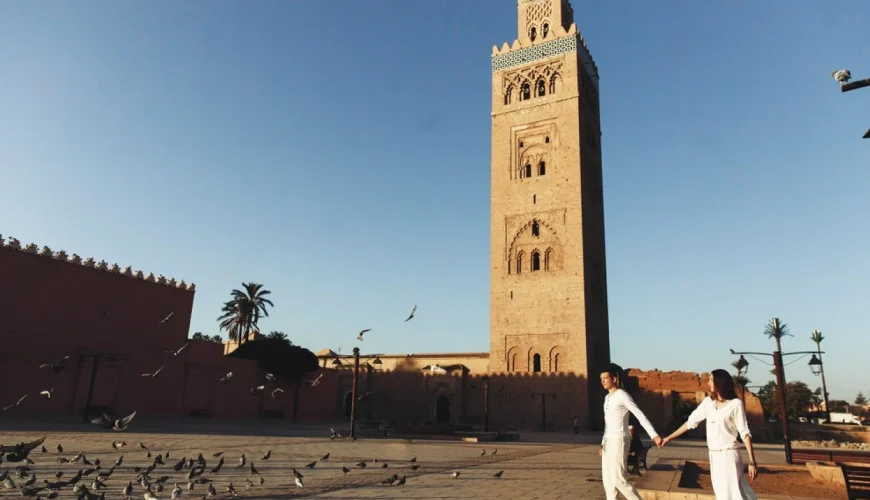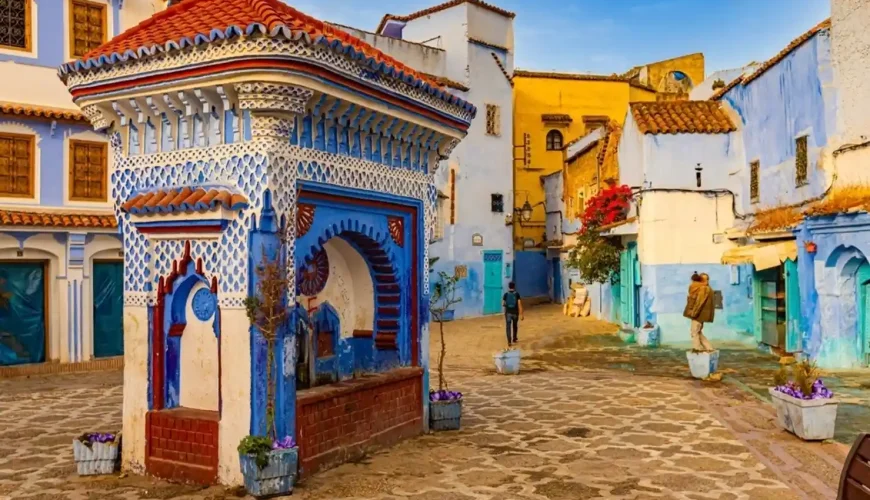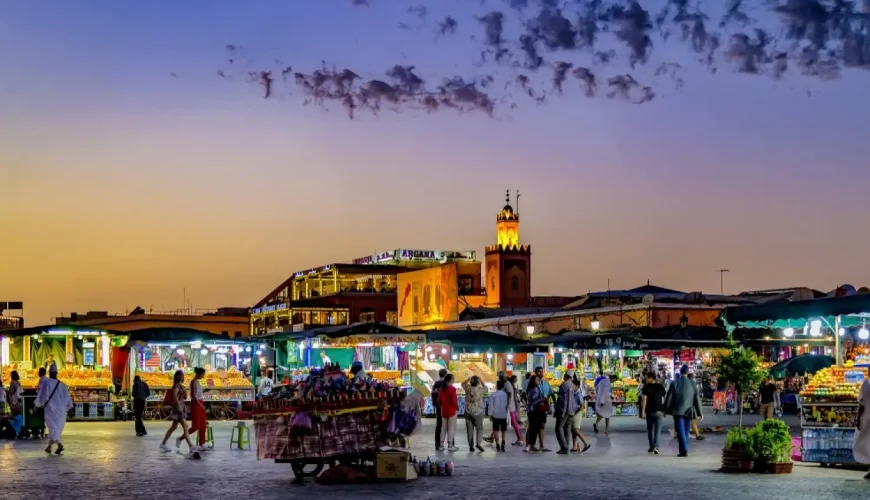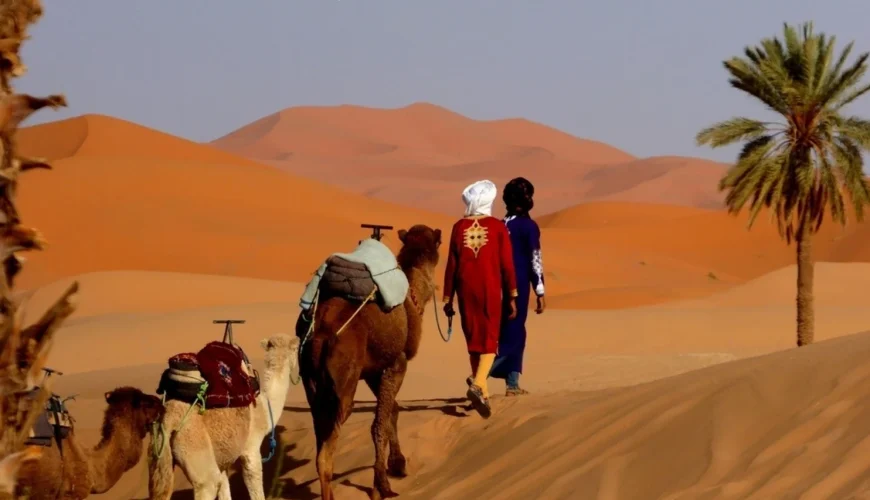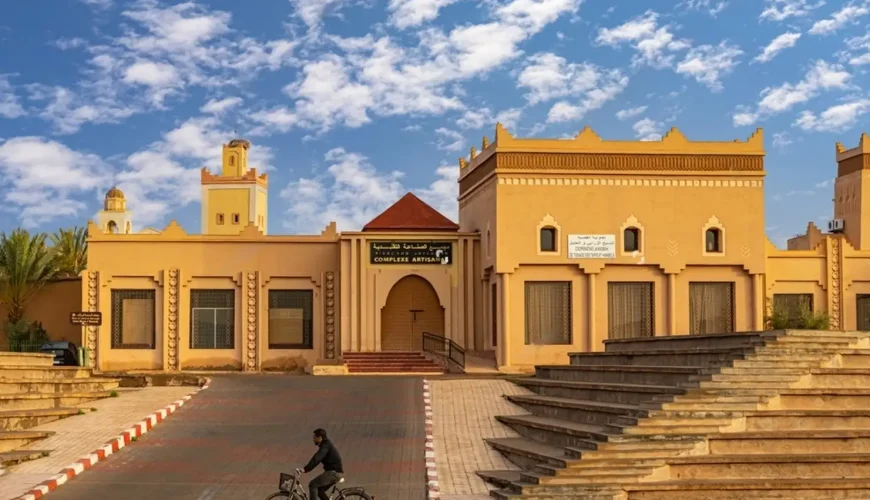A Comprehensive Guide to Morocco Desert Tours
A Comprehensive Guide to Morocco Desert Tours : Enjoy the Allure of Ouarzazate As the sun gracefully dips below the horizon, casting a warm and golden glow upon the vast, undulating landscapes of Morocco, the enchanting allure of Ouarzazate beckons travelers to a world where ancient history and cinematic marvels seamlessly intertwine. In this comprehensive Guide to Morocco Desert Tours, we extend an invitation to delve into the wonders of Morocco, with a special focus on the captivating city of Ouarzazate and the ethereal Sahara Desert. Join us on a journey to discover the magic that awaits, understand why our morocco travel, services are your ideal companion, and unravel the mysteries that surround these mesmerizing desert experiences. Ouarzazate Morocco: Gateway to Cinematic Marvels At the crossroads of the Sahara Desert and Atlas Mountains, Ouarzazate, known as the “Hollywood of Morocco,” is famed for its dramatic landscapes and ancient kasbahs. These have hosted numerous blockbuster films, making it a must-visit for film enthusiasts and travelers. Highlights include the iconic UNESCO-listed Kasbah Ait Ben Haddou and studios that have welcomed productions like Game of Thrones and Lawrence of Arabia. Choosing Ouarzazate for Your Morocco Desert Tour When considering Morocco desert tours, Ouarzazate is a must-visit for its blend of natural beauty and cinematic history. Our Morocco travel agency specializes in custom desert tours, letting you explore the landscapes that have graced the silver screen and immerse yourself in the magic of this unique city. Sahara Desert Tour: A Celestial Odyssey No exploration of Morocco is deemed complete without venturing into the mesmerizing vastness of the Sahara Desert. The golden dunes, ever-shifting under the gentle caress of the desert wind, create a celestial landscape that captivates the very soul. Our Sahara Desert tours extend beyond the ordinary, offering an odyssey into the heart of the desert’s timeless beauty. Ouarzazate to Sahara: Crafting Your Desert Adventure From the captivating city of Ouarzazate to the heart of the Sahara, our morocco travel meticulously designs itineraries that capture the essence of these two distinct yet interconnected destinations. Traverse the High Atlas Mountains, visit traditional Berber villages, and witness the transition from rocky terrains to the sea of golden sands that herald your arrival in the Sahara. Morocco Desert Tours: Beyond Ouarzazate While Ouarzazate holds a special allure, our Morocco desert tours encompass a broader spectrum of experiences. From the blue city of Chefchaouen to the bustling medinas of Marrakech, each destination adds a unique touch to your Moroccan adventure. Our agency ensures that every moment is tailored to your preferences, creating a seamless journey of discovery. Frequently Asked Questions : Navigating Morocco Desert Tours What makes Ouarzazate a standout destination for Morocco desert tours? A: Ouarzazate’s stunning landscapes and cinematic history make it a unique and captivating destination for those seeking an immersive desert experience. How can I ensure my Morocco desert tour includes Ouarzazate? A: Our morocco travel specializes in tailoring tours to your preferences. Sure! Here’s a revised version with added transition words , Simply express your interest in Ouarzazate; then,we will customize your itinerary accordingly. Furthermore, if you have specific preferences or requirements, let us know, and we will ensure that your journey meets your expectations perfectly. Are there specific attractions in Ouarzazate covered in desert tours? A: Absolutely! Kasbah Ait Ben Haddou, Atlas Film Studios, and Taourirt Kasbah are often highlights in our desert tour itineraries. Can I explore the Sahara Desert from Ouarzazate? A: Yes, many of our tours include excursions into the Sahara Desert, allowing you to experience the vastness and beauty of this iconic desert landscape. What cinematic landmarks can I visit in Ouarzazate during a desert tour? A: Ouarzazate boasts renowned film studios like Atlas and CLA Studios, offering a glimpse into the behind-the-scenes magic of filmmaking. Are English-speaking guides provided on desert tours? A: Yes, our guided tours come with knowledgeable English-speaking guides who enhance your understanding of the region’s history, culture, and attractions. Can I customize my Morocco desert tour to include specific activities? A: Absolutely! Our morocco travel specializes in crafting tailor-made experiences. Whether you desire camel trekking, cultural encounters, or a focus on cinematic landmarks, we can customize your itinerary. What’s the best time of the year for a Sahara Desert tour from Ouarzazate? A: Spring (March to May) and autumn (September to November) offer milder temperatures, providing an ideal climate for desert exploration. How does booking through a travel agency enhance the Morocco desert tour experience? A: Our agency provides a seamless and personalized experience. From expertly crafted itineraries to local insights, we ensure that every moment of your desert tour is memorable. Why is Ouarzazate a cinematic hotspot, and how can I experience it firsthand? Ouarzazate’s unique landscapes and historic sites have made it a favored location for filmmakers. Therefore, to experience it firsthand, you should book a Morocco desert tour with our agency. Consequently, let the cinematic magic unfold before your eyes In Conclusion: Your Gateway to Ouarzazate and Beyond In conclusion, Ouarzazate’s cinematic allure and the Sahara Desert’s celestial beauty together represent the crown jewels of Morocco’s wonders. Our morocco travel , armed with its expertise in crafting tailored experiences, serves as your gateway to these mesmerizing destinations. Book your Morocco desert tour today, and let the exploration of Ouarzazate and the Sahara unfold. Immerse yourself in Morocco’s magic with a personalized touch, as our agency turns your travel dreams into an unforgettable journey.
Moroccan Berber rugs
Moroccan Berber rugs: purely traditional craftsmanship In the heart of Morocco, amidst the stunning landscapes and vibrant culture, lies a timeless tradition of crafting exquisite Moroccan Berber rugs. These rugs, known for their intricate designs, rich history, and unparalleled craftsmanship, are more than just floor coverings. They are a symbol of the heritage and artistic prowess of the Berber people, who have been weaving these masterpieces for centuries. The Origin of Berber Rugs Berber rugs, originating from Morocco’s indigenous Berber tribes, have been crafted for thousands of years. Each rug tells a unique story through symbols and patterns that reflect the weaver’s personal experiences, tribal identity, and natural surroundings. Traditionally, Berber women have been the custodians of this craft, passing down their skills from generation to generation. The Berber tribes, including the Beni Ourain, Azilal, and Boucherouite, each have their unique weaving styles and techniques. Beni Ourain rugs, for example, are renowned for their minimalistic designs, typically featuring black and white geometric patterns on a creamy background. Azilal rugs, on the other hand, are known for their vibrant colors and abstract patterns, often incorporating wool, cotton, and recycled fabrics. The Craftsmanship Behind Berber Rugs Creating a Berber rug is a labor-intensive process that requires patience, skill, and a deep understanding of traditional weaving techniques. The process begins with the shearing of sheep to obtain high-quality wool, which is then cleaned and spun into yarn. This wool is often dyed using natural ingredients such as indigo, saffron, and henna, which not only provide beautiful colors but also ensure that the rugs remain environmentally friendly. Once the yarn is ready, the weavers set up a vertical loom, which is used to hand-knot each thread. This meticulous process can take weeks or even months, depending on the size and complexity of the rug. The weavers work without a pattern, relying on their memory and creativity to guide their hands. This results in each rug being a unique piece of art, with no two rugs ever being exactly alike. Symbolism and Meaning in Berber Rugs A Quick Guide to Moroccan Rugs Symbolism | Every Rug Has A Story Berber rugs are more than just decorative items; they are rich in symbolism and cultural significance. The patterns and motifs woven into the rugs often represent aspects of daily life, nature, and spirituality. Common symbols include the diamond, which represents protection against evil spirits, and the triangle, which symbolizes fertility and womanhood.The colors used in Berber rugs also hold special meaning. Red is often associated with strength and protection, blue symbolizes wisdom and tranquility, green represents peace and nature, and yellow signifies eternity and the sun. These elements combined make each rug a narrative of the weaver’s life and beliefs. Modern Appeal and Versatility Despite their ancient origins, Berber rugs have found a place in modern homes around the world. Their versatility and timeless appeal make them a popular choice for interior designers and homeowners alike. Whether placed in a contemporary living room, a cozy bedroom, or a rustic dining area, Berber rugs add a touch of warmth, texture, and authenticity to any space. One of the reasons for their enduring popularity is their ability to blend seamlessly with various decor styles. The neutral tones of Beni Ourain rugs complement minimalist and Scandinavian interiors, while the vibrant hues of Azilal and Boucherouite rugs add a pop of color to bohemian and eclectic spaces. Additionally, the durability and craftsmanship of these rugs ensure that they can withstand the test of time, making them a worthwhile investment for any home. Supporting Sustainable and Ethical Practices Buying a Moroccan Berber rug adds beauty and uniqueness to your home while supporting sustainable and ethical practices. Many cooperatives and artisans use fair trade principles to ensure fair wages for weavers. By choosing these sources, you help preserve traditional crafts and empower Berber communities. Caring for Your Berber Rug To maintain your Berber rug’s beauty and longevity, care for it properly. Regular vacuuming removes dust and dirt, while occasional professional cleaning preserves color and fiber strength. If spills occur, blot the area immediately with a clean, damp cloth. Avoid harsh chemicals and rubbing, as they can damage the wool and natural dyes. In conclusion, Moroccan Berber rugs celebrate traditional craftsmanship, embodying the rich cultural heritage and artistic talent of the Berber people. Each rug is a unique masterpiece, woven with care and imbued with meaning. Enhance your home with a Berber rug, adding art and supporting a centuries-old tradition that thrives today.
Guide to Marrakech: How to Plan the Perfect Trip
How to Plan the Perfect Trip: Guide to Marrakech Guide to Marrakech, the enchanting city in Morocco, is a vibrant blend of history, culture, and modernity. Known for its bustling souks, stunning palaces, and rich traditions, it offers an unforgettable travel experience. If you’re planning a trip to this magical destination, here’s a comprehensive guide to help you plan the perfect Marrakech adventure. Getting guide to Marrakech The first step in planning your trip to Marrakech is figuring out how to get there. Marrakech Menara Airport (RAK) is well-connected with major cities around the world. Numerous airlines offer direct flights to Marrakech, making it accessible from various international destinations. Once you arrive, taxis and airport shuttles are readily available to take you to your accommodation. Best Time to Visit Marrakech enjoys a Mediterranean climate with hot summers and mild winters. The best time to visit is during the spring (March to May) and autumn (September to November) when the weather is pleasant and ideal for exploring the city. Summer can be scorching, while winter nights can get quite chilly, so plan your trip accordingly. Accommodation Options Marrakech offers a wide range of accommodation options to suit every budget and preference. From luxurious riads (traditional Moroccan houses with interior courtyards) to budget-friendly hostels, you’ll find something that fits your needs. Staying in a riad is highly recommended for an authentic Moroccan experience. Popular areas to stay include the Medina (old city) and the modern district of Gueliz. Exploring the Medina The heart of Marrakech is its Medina, a UNESCO World Heritage site. This labyrinth of narrow streets and alleyways is home to bustling souks (markets), historic sites, and vibrant squares. Start your exploration at Jemaa el-Fnaa, the main square, where you’ll find food stalls, street performers, and a lively atmosphere. Nearby, visit the Koutoubia Mosque, the largest mosque in Marrakech, known for its stunning minaret. Must-See Attractions Bahia Palace: This 19th-century palace boasts beautiful gardens, intricate tilework, and stunning architecture. It’s a great place to learn about Moroccan history and culture. Saadian Tombs: Discovered in 1917, these tombs date back to the Saadian dynasty and are a must-visit for history enthusiasts. The intricate carvings and ornate decorations are truly impressive. Majorelle Garden: Created by French painter Jacques Majorelle and later restored by fashion designer Yves Saint Laurent, this garden is a peaceful oasis in the city. The vibrant blue buildings and exotic plants make it a photographer’s paradise. El Badi Palace: Once a grand palace, now in ruins, El Badi offers a glimpse into Marrakech’s past. The large courtyard and surrounding walls are perfect for exploring and taking in the views. Experiencing Moroccan Cuisine No trip to Marrakech is complete without indulging in Moroccan cuisine. The city’s food scene is a delightful mix of flavors and aromas. Try traditional dishes like tagine (slow-cooked stew), couscous, and pastilla (a savory-sweet pastry). Street food is also a highlight, with vendors selling everything from fresh orange juice to spicy merguez sausages. Don’t forget to visit a traditional Moroccan tea house for some mint tea and pastries. Shopping in the Souks The souks of Marrakech are a shopper’s paradise. These bustling markets offer a wide variety of goods, from spices and textiles to jewelry and pottery. Bargaining is a common practice, so be prepared to haggle for the best prices. Some popular items to buy include Moroccan rugs, lanterns, and argan oil products. For a more organized shopping experience, visit the Ensemble Artisanal, where you’ll find high-quality handicrafts at fixed prices. Day Trips and Excursions Marrakech is also a great base for exploring the surrounding areas. Consider taking a day trip to the Atlas Mountains, where you can hike, visit Berber villages, and enjoy stunning scenery. Another popular excursion is a visit to the Ouzoud Waterfalls, located about 150 kilometers from Marrakech. For a unique experience, spend a night in the Sahara Desert. Various tours offer camel rides, sandboarding, and overnight stays in desert camps. Practical Tips Dress Modestly: While Marrakech is quite tourist-friendly, it’s respectful to dress modestly, especially when visiting religious sites. Stay Hydrated: The dry climate can be dehydrating, so drink plenty of water throughout your stay. Use Maps: The Medina can be confusing to navigate. Use a map or GPS to help find your way around. Be Aware of Scams: Like any popular tourist destination, Marrakech has its share of scams. Be cautious and use common sense when dealing with strangers. Conclusion Planning the perfect trip to Marrakech involves a mix of cultural exploration, culinary delights, and adventurous excursions. With its rich history, vibrant atmosphere, and welcoming locals, Marrakech promises a memorable travel experience. Use this guide to plan your journey and immerse yourself in the magic of this Moroccan gem.
Packing for Morocco: Essential Items for Your Adventure
Packing for Morocco: Essential Items for Your Adventure Packing for Morocco is an exciting adventure filled with vibrant culture, stunning landscapes, and rich history. From the bustling souks of Marrakech to the serene dunes of the Sahara, Morocco offers a diverse range of experiences. To ensure your trip is comfortable and enjoyable, packing the right essentials is crucial. Here’s a comprehensive guide to help you prepare for your Moroccan adventure. 1. Climate-Appropriate Clothing Morocco’s climate varies significantly across different regions and seasons. Here’s what you should consider packing: Lightweight, Breathable Fabrics: In summer, especially in cities like Marrakech and Fes, temperatures can soar. Pack light, breathable clothing made from natural fabrics like cotton and linen to stay cool. Layering Pieces: Evenings in the desert and mountainous areas can be chilly, so bring layers such as a light jacket, sweater, or shawl. Modest Attire: Respect local customs by packing modest clothing. Women should consider packing long skirts, pants, and tops with sleeves. Men should avoid shorts in more conservative areas. Comfortable Footwear: Whether you’re exploring city streets or hiking in the Atlas Mountains, comfortable walking shoes are a must. Sandals with good support are great for the hotter months. 2. Essential Travel Accessories Certain accessories can make your travel experience much smoother: Wide-Brimmed Hat and Sunglasses: Protect yourself from the intense Moroccan sun with a wide-brimmed hat and UV-protective sunglasses. Scarf or Shawl: A versatile item, a scarf can be used for sun protection, warmth in cooler evenings, or as a cover-up when visiting religious sites. Reusable Water Bottle: Staying hydrated is crucial, especially in the desert. A reusable water bottle will help you keep water handy. Daypack: A small, lightweight backpack is perfect for carrying your daily essentials, such as a water bottle, snacks, and a camera. 3. Health and Safety Essentials Ensuring your health and safety while traveling is paramount: Sunscreen and Lip Balm: Protect your skin and lips from the harsh sun with high-SPF sunscreen and a moisturizing lip balm. First Aid Kit: Pack a basic first aid kit with band-aids, antiseptic wipes, pain relievers, and any necessary prescription medications. Hand Sanitizer and Wet Wipes: Keeping your hands clean is important, especially when soap and water are not readily available. Insect Repellent: In some areas, mosquitoes can be a nuisance, so bring insect repellent to prevent bites. 4. Travel Documents and Money Organizing your travel documents and money beforehand can save you a lot of hassle: Passport and Visa: Ensure your passport is valid for at least six months from your date of entry. Check if you need a visa to enter Morocco and obtain it in advance if necessary. Copies of Important Documents: Make photocopies or digital backups of your passport, visa, travel insurance, and any other important documents. Cash and Cards: While credit cards are widely accepted in major cities, carrying some cash in Moroccan Dirhams is essential for smaller towns and markets. Inform your bank of your travel plans to avoid issues with card usage. 5. Tech Gadgets A few tech essentials can enhance your travel experience: Camera or Smartphone: Morocco’s vibrant landscapes and architecture are a photographer’s dream. Ensure you have a good camera or a smartphone with ample storage for photos. Portable Charger: Keeping your devices charged is important, especially on long excursions. A portable charger ensures you don’t run out of battery. Universal Power Adapter: Morocco uses the European-style plug (types C and E), so bring a universal adapter to charge your devices. 6. Cultural Considerations Understanding and respecting local customs will enrich your travel experience: Language Guide: While Arabic and Berber are the official languages, French is widely spoken. A pocket-sized language guide or translation app can be very helpful. Respectful Attitude: Be mindful of local customs, especially in religious and conservative areas. Showing respect for local traditions will enhance your interactions with locals. 7. Specialty Items for Specific Activities Depending on your itinerary, you might need some specialty items: Hiking Gear: If you plan to trek in the Atlas Mountains, pack appropriate hiking boots, a hat, and possibly trekking poles. Desert Essentials: For a Sahara desert excursion, pack loose, long clothing to protect against the sun and sand, and a scarf for sandstorms. Final Thoughts Packing for Morocco requires thoughtful consideration of the climate, cultural norms, and your planned activities. By bringing the right essentials, you’ll be well-prepared to fully enjoy the wonders of this enchanting country. Remember to leave some space in your luggage for the unique souvenirs you’ll undoubtedly want to bring home from your Moroccan adventure. Safe travels!
What to Wear in Morocco: A Traveler’s Guide
Morocco, a land of diverse landscapes and rich cultural heritage, is a dream destination for many travelers. From the bustling markets of Marrakech to the serene sands of the Sahara Desert, the country offers a unique blend of experiences. However, dressing appropriately is essential to respect local customs and ensure comfort during your travels. Here’s a comprehensive guide on what to wear in Morocco. Understanding the Climate Morocco’s climate varies significantly depending on the region and the time of year. Coastal areas like Casablanca and Rabat enjoy a Mediterranean climate, with mild winters and hot summers. Inland cities such as Marrakech and Fes experience more extreme temperatures, with scorching summers and chilly winters. The desert regions, including the famous Sahara, can be sweltering during the day and freezing at night. Tip: Check the weather forecast for your specific travel dates and destinations to pack accordingly. General Dressing Tips for Morocco Respect the Culture: Morocco is a predominantly Muslim country with conservative dress codes. While you don’t need to dress like a local, modest clothing is appreciated. For women, this means covering the shoulders, cleavage, and knees. Men should avoid wearing shorts above the knee. Comfort is Key: Opt for lightweight, breathable fabrics such as cotton or linen to stay cool in the heat. Loose-fitting clothes are also more comfortable and culturally appropriate. Layering is Essential: Due to the significant temperature variations, especially in desert areas, layering is crucial. Pack a light jacket or sweater for cooler evenings and early mornings. What Women Should Wear Tops: Long-sleeved shirts, blouses, and tunics made from lightweight materials are ideal. T-shirts are acceptable as long as they cover the shoulders and have a modest neckline. Bottoms: Long skirts, maxi dresses, and loose pants are perfect for Morocco. They are comfortable, breathable, and culturally appropriate. If you prefer wearing pants, choose loose-fitting styles over tight jeans or leggings. Accessories: A scarf or shawl is a versatile accessory. It can be used to cover your head when visiting mosques, protect against the sun, or provide an extra layer in the evenings. Footwear: Comfortable walking shoes are essential, especially for exploring cities and markets. Sandals are great for the beach and casual outings, but ensure they are sturdy enough for walking on uneven surfaces. Beachwear: Swimsuits are acceptable at private beaches, hotels, and resorts. However, it’s advisable to wear a cover-up when moving away from the beach or pool area. What Men Should Wear Tops: Short-sleeved shirts, T-shirts, and polos are fine, but avoid sleeveless tops. Long-sleeved shirts are preferable for protection against the sun and to respect local customs. Bottoms: Lightweight trousers, chinos, and long shorts are suitable for men. Avoid wearing shorts that are too short, especially in conservative areas. Accessories: A hat or cap is useful for sun protection. Sunglasses are also recommended. Footwear: Comfortable, sturdy shoes are a must for exploring. Sandals can be worn, but ensure they are appropriate for walking. Special Considerations for Different Regions Cities (Marrakech, Fes, Casablanca): In urban areas, the dress code is slightly more relaxed, especially in tourist zones. However, it’s still important to dress modestly. Lightweight, modest clothing will keep you comfortable and respectful. Desert (Sahara): For desert trips, breathable, loose clothing is essential. Long sleeves and pants will protect you from the sun and sand. A wide-brimmed hat and sunglasses are also crucial. At night, temperatures can drop sharply, so pack a warm jacket or sweater. Mountains (Atlas Mountains): If you’re trekking or exploring the Atlas Mountains, be prepared for cooler temperatures, especially at higher altitudes. Layered clothing, sturdy hiking boots, and a warm jacket are necessary. Packing List for Morocco Long-sleeved shirts and blouses T-shirts with modest necklines Long skirts, maxi dresses, and loose pants Light jacket or sweater Comfortable walking shoes and sandals Scarf or shawl Hat or cap for sun protection Sunglasses Swimsuit and cover-up for beach areas Warm clothing for desert nights and mountain areas Final Tips Respecting local customs while traveling in Morocco not only shows cultural sensitivity but also enhances your travel experience. Dressing modestly and appropriately ensures you feel comfortable and confident as you explore this fascinating country. Whether you’re wandering through ancient medinas, hiking in the mountains, or riding camels in the desert, being prepared with the right clothing will make your Moroccan adventure truly memorable.
Best Fes to Marrakech Luxury Desert Tours
Best Fes to Marrakech Luxury Tours Introduction If you’re considering a trip to Morocco, the best Fes to Marrakech luxury tours provide an incredible opportunity to explore the country’s enchanting landscapes and rich culture. These tours blend comfort and adventure, allowing you to experience the breathtaking Sahara Desert in style. Here’s your guide to the best Fes to Marrakech luxury tours, highlighting must-see attractions and top-rated tour companies. 1. Why Choose Luxury Desert Tours? Opting for the best Fes to Marrakech luxury tours ensures a unique experience tailored to your preferences. Here are some compelling reasons: Comfort and Style: Enjoy top-notch accommodations, private transport, and gourmet meals throughout your journey. Customized Itineraries: Luxury tours often allow you to personalize your itinerary, making sure you visit the sights that interest you most. Expert Local Guides: Gain insights into Morocco’s rich history and culture from knowledgeable guides who enhance your travel experience. 2. Top Luxury Desert Tour Companies When planning your luxury desert tour, consider these reputable companies known for their exceptional service: A. Morocco Luxury Tours Morocco Luxury Tours specializes in creating custom itineraries that focus on luxury and comfort. Their packages typically include a visit to the stunning Merzouga dunes, camel trekking, and a stay in a luxury desert camp. For more information, visit Morocco Luxury Tours. B. Sahara Desert Tours Sahara Desert Tours offers premium experiences with a focus on quality service. Their Fes to Marrakech luxury tours include visits to the Atlas Mountains and authentic Moroccan cuisine, ensuring a comprehensive journey. Check out their offerings at Sahara Desert Tours. C. Journey to Morocco Journey to Morocco is renowned for its luxury tours that emphasize adventure and cultural experiences. They provide personalized options, ensuring your travel is tailored to your desires. Learn more at Journey to Morocco. 3. Must-See Attractions on Your Luxury Tour Your best Fes to Marrakech luxury tours will include several stunning locations and experiences: A. The Middle Atlas Mountains As you journey from Fes to Marrakech, the picturesque Middle Atlas Mountains provide breathtaking scenery. Stop in charming towns like Ifrane, known for its beautiful parks and unique Swiss-inspired architecture. For more tips on exploring Moroccan landscapes, check out our guide on Scenic Routes in Morocco. B. The Sahara Desert Experience No desert tour is complete without exploring the Sahara. Enjoy camel rides across the golden dunes of Merzouga and spend a magical night in a luxury desert camp under the starry sky. Experience the beauty of traditional Berber culture and indulge in delicious Moroccan cuisine. For more desert adventures, explore our article on Adventure Tours in the Sahara Desert. C. Ait Ben Haddou A UNESCO World Heritage site, Ait Ben Haddou is famous for its stunning kasbahs and breathtaking views. This historical site has been a backdrop for many films, making it a must-visit on your journey. For more details, visit the UNESCO site. 4. Tips for Booking Your Luxury Desert Tour Book Early: The best Fes to Marrakech luxury tours can fill up quickly, especially during peak seasons. Ensure you reserve your spot well in advance. Read Reviews: Websites like TripAdvisor provide valuable insights from fellow travelers about different tour companies and experiences. Customize Your Tour: Many luxury providers allow you to tailor your itinerary. Don’t hesitate to discuss your interests and preferences with your tour operator. Conclusion Choosing the best Fes to Marrakech luxury tours is a fantastic way to experience the magic of Morocco. From the breathtaking landscapes of the Sahara to the rich cultural heritage of the Middle Atlas Mountains, this journey promises to be unforgettable. Embrace the beauty of Morocco and create lasting memories on your luxury desert adventure!
when is the best time to go to Morocco?
When is the Best Time to Go to Morocco? Planning a trip to Morocco involves considering various factors, including the best time to visit based on weather, activities, and festivals. This guide will help you determine the ideal timing for your Moroccan adventure. 1. Seasonal Overview: Best Times to Visit Morocco Spring (March to May) Spring is one of the best times to visit Morocco, offering mild weather with temperatures ranging from 60°F to 80°F (15°C to 27°C). This season showcases beautiful blooming landscapes, making it perfect for outdoor activities like hiking in the Atlas Mountains. Best for: Nature lovers and outdoor exploration. Summer (June to August) Summer can be quite hot in Morocco, particularly in inland areas like Marrakech and Fes, where temperatures often exceed 100°F (38°C). Coastal cities like Essaouira and Agadir provide a more temperate climate but can be crowded with tourists. If you’re a beach enthusiast, this is a great time to visit the coast. Best for: Beachgoers and sun seekers. Fall (September to November) Fall in Morocco mirrors the pleasant temperatures of spring, making it an ideal time for city exploration and cultural festivals, such as the Fes Festival of World Sacred Music. Expect temperatures between 60°F to 80°F (15°C to 27°C) during this season. Best for: Cultural experiences and festival-goers. Winter (December to February) Winter temperatures in Morocco can vary significantly by region. Coastal cities remain mild, but it can get quite cold in the mountains and deserts, with nighttime temperatures dropping below 32°F (0°C). This season offers fewer tourists and lower travel costs, making it suitable for budget travelers. Best for: Travelers seeking peace and lower prices. 2. Notable Events and Festivals in Morocco If you’re looking to immerse yourself in Moroccan culture, consider timing your visit with one of the country’s many festivals. Here are a few notable ones: Mawazine (May): A major music festival in Rabat featuring local and international artists. More information is available at the Mawazine Festival. Fes Festival of World Sacred Music (June): This festival celebrates spiritual music from around the world and attracts both artists and visitors. Find more details at the Fes Festival. Marrakech International Film Festival (December): This festival showcases international films and attracts celebrities and film enthusiasts. Learn more at the Marrakech Film Festival. 3. Weather Considerations for Visiting Morocco When planning your trip, it’s essential to consider how Morocco’s climate varies by region: Coastal Areas: Typically mild and wet, perfect for beach activities. Inland Cities: Experience hot summers and mild winters, ideal for sightseeing. Atlas Mountains: Cold winters with snow, great for winter sports or hiking. 4. Conclusion: Choosing the Best Time for Your Trip to Morocco The best time to visit Morocco largely depends on your travel preferences, whether you’re interested in pleasant weather, cultural experiences, or adventure activities. With a range of seasons to choose from, there’s a perfect time for you to explore this beautiful country. For more travel insights, check out our articles on Exploring Moroccan Cuisine and Top Destinations in Morocco, and don’t forget to read our tips on Travel Tips for Morocco.
The New Travel Restrictions to Morocco from the USA
The New Travel Restrictions to Morocco from the USA Traveling to Morocco from the USA can be an exciting experience, but it’s essential to stay informed about the latest travel restrictions and requirements. As of 2024, there have been updates to the travel regulations that may impact your journey. Here’s everything you need to know about the new travel restrictions to Morocco from the USA. 1. Current Entry Requirements As of now, travelers from the USA must meet specific entry requirements before visiting Morocco. Here’s what you need to keep in mind: Visa Requirements: U.S. citizens can enter Morocco without a visa for up to 90 days for tourism or business purposes. However, always check the latest updates on visa regulations on the U.S. Department of State website. COVID-19 Restrictions: While many countries have relaxed their COVID-19 restrictions, it’s crucial to check Morocco’s current health and safety guidelines. As of now, travelers may need to provide proof of vaccination or a negative COVID-19 test result taken within a specific timeframe before arrival. Visit the World Health Organization for the most recent updates on travel health recommendations. Link to your website’s article on “Travel Tips for Visiting Morocco” for further guidance on planning a trip. 2. Health and Safety Protocols Morocco has implemented several health and safety protocols to ensure the safety of both locals and tourists. Here are the key measures you should be aware of: Mask Mandates: Depending on the current health situation, masks may still be required in indoor public spaces, crowded areas, and on public transportation. Check local guidelines before your trip. Vaccination Requirements: Travelers are encouraged to be fully vaccinated against COVID-19. Proof of vaccination might be required at certain establishments. For detailed health information specific to Morocco, refer to the Moroccan Ministry of Health. Link to your article on “Health and Safety in Morocco” for more travel health tips. 3. Transportation Guidelines Travelers should also be aware of transportation regulations when visiting Morocco. Here are the latest updates: Public Transportation: Buses, taxis, and trains are operating under health protocols. Social distancing may be encouraged, and masks are likely required. Air Travel: Airlines may have specific requirements regarding testing and vaccination. It’s essential to check with your airline before your departure. Visit Airlines for America for information on airline-specific travel updates and safety protocols. 4. Cultural Considerations Understanding local customs is always vital when traveling to a new country. Morocco has a rich culture, and respecting local traditions enhances your travel experience. Dress Code: While Morocco is more liberal than some other countries, modest dress is appreciated, particularly in rural areas and religious sites. For tips on what to wear, check our article on “What to Wear in Morocco.” Local Etiquette: Familiarize yourself with Moroccan customs, such as greeting locals with a friendly “salam” (hello) and understanding dining etiquette. Learn more about Moroccan customs and etiquette on the Moroccan National Tourist Office website. Conclusion As travel restrictions continue to evolve, staying informed is key to having a smooth and enjoyable trip to Morocco from the USA. Make sure to check the latest entry requirements, health protocols, and cultural practices before your departure. By being prepared, you can fully enjoy all that Morocco has to offer.
Best Morocco Desert Tours from Casablanca
[vc_row][vc_column][vc_column_text]If you long to visit the Sahara desert and trek with camels as you watch the mind-blowing sunset over the horizon, then the Morocco desert tours from Casablanca are for you. Visiting the Sahara desert is a once-in-a-lifetime experience that you don’t want to miss. Mountains of sand dunes, big rock canyons, vast oases, and mud-walled houses reflect the charm of the desert, not to mention the magic of Berbers and the hospitality of Moroccans. By traveling to the desert from Casablanca, travelers will have the chance to experience camel trekking, sunsets and sunrises, camping under the starry sky, and maybe even see the shooting stars! In addition, one will experience enticing history, warm culture, welcoming locals, and delicious food. This place is colorful, mythical, and ethereal. What else can a tourist ask for? However, traveling to such an electric and grand place can be overwhelming. One can’t opt to wing it with so many places to discover. We are here to help you. Undertaking numerous tourist reviews and local intel, we have put together Morocco’s best trips to the desert that you can take from Casablanca. Before you soak up Morocco’s charming imperial cities on horse-led carriages or drool on Moroccan pastries, please go through our guide to make the best of your time and money. Note: Are you confused about planning your Morocco trip? Please sit back and let us do all the heavy work for you. Our team of travel experts, along with trusted local insiders, design 100% authentic, hassle-free, and customizable experiences to fit what our clients demand and desire.[/vc_column_text][vc_empty_space][/vc_column][/vc_row][vc_row][vc_column][vc_custom_heading text=”Why You Should Explore the Sahara Desert of Morocco” font_container=”tag:h2|text_align:center|color:%23000000″ google_fonts=”font_family:Courgette%3Aregular|font_style:400%20regular%3A400%3Anormal”][vc_empty_space][vc_single_image image=”15534″ img_size=”full” alignment=”center”][vc_empty_space][vc_column_text]Exploring the Sahara desert from Casablanca is very common as many travelers land in this city since it holds the largest airport in Morocco. Many travel operators schedule tours from there to the desert on a regular basis. The tours are all-inclusive, tourist-friendly, and cost-effective. Tourists are attracted to Morocco by the light, the colors, and the harmony of its traditional architecture. It is a bustling tourism destination sporting a blend of old and new in perfect harmony. Tourists love its enchanting charm and panoramic views for all the good reasons. The country boasts a mix of old European elegance, Islamic imperial grandeur, and endless diversity. The European influence on the Arabic and African blend is evident in large cities, particularly Marrakesh, Casablanca, and Fes. These cities are lined with monuments standing for millennia, Persian-style art galleries, and Islamic palaces.[/vc_column_text][vc_empty_space][/vc_column][/vc_row][vc_row row_fullwidth=”yes” css=”.vc_custom_1591570559533{background-image: url(https://www.moroccotravel.co/wp-content/uploads/2020/06/morocco-tour-travel.jpg?id=9583) !important;background-position: 0 0 !important;background-repeat: no-repeat !important;}”][vc_column width=”2/3″][vc_custom_heading text=”Book your tour to the land of dreams Morocco desert and camels” font_container=”tag:h4|text_align:center|color:%23ffffff” google_fonts=”font_family:Courgette%3Aregular|font_style:400%20regular%3A400%3Anormal” css=”.vc_custom_1591663091877{background-position: center !important;background-repeat: no-repeat !important;background-size: contain !important;}”][/vc_column][vc_column width=”1/3″ css=”.vc_custom_1590855939512{border-top-width: 30px !important;}”][vc_btn title=”Book your tour” color=”warning” align=”center” css_animation=”fadeInUpBig” link=”|title:https%3A%2F%2Fwww.moroccotravel.co%2Ftours|target:%20_blank|” css=”.vc_custom_1590857563377{margin-top: 30px !important;margin-right: 40px !important;background-position: center !important;background-repeat: no-repeat !important;background-size: contain !important;}”][/vc_column][/vc_row][vc_row][vc_column][vc_empty_space][vc_column_text]UNESCO has declared Fes a World-Heritage site. It is also referred to as the Mecca of the West. Marrakesh is the gateway to the Sahara and boasts a well-established Mediterranean culture. Casablanca is a crucial productive, and financial city titled the New York of Morocco. The blue city of Chefchauen, with the walls painted in electric blue color, seems to be of another world. When you read all that, you find it logical why many prize-winning Hollywood movies have been filmed in Morocco. Regardless of its contradictions, it remains a charming country that stimulates the fantasies of the west, especially when we talk about magic and exoticism. What’s more, Morocco ix the gate to the biggest desert in the world. In Merzouga, you will see things you have never seen before. It’s for sure you fall under its spell. During your visit, you will experience the following: Camping in the desert and trekking with camels The 2nd most “Instagrammed” Game of Thrones Site, is Ait Benhaddou. Strolling into the cinema studio of Quarzazate Hiking in the high Atlas mountains Meeting locals and enjoying Berber food and music With that being said, all desert tours from Casablanca are created by a local guide; that is to say, you will see places other tourists can’t reach.[/vc_column_text][/vc_column][/vc_row][vc_row][vc_column][vc_empty_space][vc_custom_heading text=”The Best Time for Morocco Desert Tours From Casablanca” font_container=”tag:h2|text_align:center|color:%23000000″ google_fonts=”font_family:Courgette%3Aregular|font_style:400%20regular%3A400%3Anormal”][vc_empty_space][vc_column_text]Morocco has been described as a cold country with extreme heat. In fact, its climate, although undeniably hot in summer, is extremely varied, and some regions can be quite cold. The pre-Sahara and the desert are subject to desert conditions; scorching hot temperatures during the day and bitter cold at night. Morocco desert tours from Casablanca are the highlight for so many tourists, but the best time to book this tour is from March to May and from September to December as the day temperature ranges from 59 °F (15 °C) to 84 °F (29 °C). Some tour locations include the hottest places in Morocco, which are extremely hot during the summer period; the day temperature ranges from 107 °F (42 °C) or even further. Hence, it’s important to note that spring and autumn are the peak seasons in Morocco. This period also witnesses a drop in ticket prices, which makes it the perfect time for desert tours.[/vc_column_text][/vc_column][/vc_row][vc_row][vc_column][vc_empty_space][vc_custom_heading text=”Best Morocco Desert Tours from Casablanca” font_container=”tag:h2|text_align:center|color:%23000000″ google_fonts=”font_family:Courgette%3Aregular|font_style:400%20regular%3A400%3Anormal”][vc_empty_space][vc_single_image image=”15536″ img_size=”full” alignment=”center”][vc_empty_space][vc_column_text]If you’re seeking the Best Morocco Desert Tours from Casablanca, you’ve come to the perfect place. Tourists from all over the world come to experience Morocco’s striking landscapes, from the bustling streets of Casablanca to the stunning Sahara desert dunes. There is nothing to miss. Morocco is known as a land of contrasts, colors, fascinating scenes of daily life, and the magic of the night sky in the Sahara desert. The desert offers a truly magical experience. A true sight to behold when the day ends, and the colorful spectacle begins; the desert begins to unfold its full calm and enchanting power. Are you ready to discover the desert? We have put together some of the best tours that you can book from Casablanca. All of them include the beautiful desert.[/vc_column_text][/vc_column][/vc_row][vc_row][vc_column][vc_empty_space][vc_custom_heading text=”15-day Desert Tour From Casablanca” font_container=”tag:h2|text_align:center|color:%23000000″ google_fonts=”font_family:Courgette%3Aregular|font_style:400%20regular%3A400%3Anormal”][vc_empty_space][vc_column_text]The
Best Holiday Packages to Morocco
Best Holiday Packages to Morocco Morocco is a land of contrasts, where ancient traditions blend seamlessly with modern life. From the bustling souks of Marrakech to the serene landscapes of the Sahara Desert, the country offers an unforgettable experience for every type of traveler. If you’re planning a trip to this enchanting destination, consider booking one of the best holiday packages to Morocco. These packages often include accommodation, meals, transportation, and guided tours, allowing you to focus on enjoying your adventure. Here’s a look at some of the top holiday packages available. 1. Cultural Discovery Packages Explore Morocco’s rich heritage and vibrant culture with packages designed to immerse you in the local way of life. Here are some excellent options: Morocco Heritage Tour: Companies like G Adventures offer comprehensive cultural tours that include visits to iconic cities such as Marrakech, Fes, and Chefchaouen. These packages often feature guided city tours, cooking classes, and traditional music performances. Cultural Immersion Experiences: Consider packages that allow you to stay with local families or participate in community events. Intrepid Travel provides unique opportunities for travelers to engage with local communities. For more cultural insights, check our article on “Moroccan Traditions and Customs.” 2. Adventure and Nature Packages For adventure enthusiasts, Morocco offers a variety of holiday packages that include thrilling outdoor activities. Here are some top picks: Sahara Desert Adventures: Experience the magic of the Sahara with all-inclusive packages that include camel trekking, sandboarding, and camping under the stars. Desert Morocco Adventure offers tailored experiences that cater to different interests and budgets. Atlas Mountains Treks: Explore the breathtaking scenery of the Atlas Mountains with guided hiking packages. Companies like Trekking in Morocco provide various trekking options suitable for all skill levels. For more information on outdoor activities in Morocco, visit the Moroccan National Tourist Office. 3. Luxury Holiday Packages Indulge in the opulence of Morocco with luxury holiday packages that focus on comfort and exclusive experiences. Here are some luxurious options: Five-Star Resort Stays: Stay at top-tier hotels like La Mamounia in Marrakech, where you can enjoy lavish accommodations, gourmet dining, and spa services as part of your holiday package. Private Guided Tours: Consider luxury packages that offer private guides for a more personalized experience. Abercrombie & Kent specializes in luxury travel and can create bespoke itineraries to suit your preferences. For more on where to stay, check our article on “Top Luxury Hotels in Morocco.” 4. Family-Friendly Packages Traveling with children? Look for holiday packages that cater specifically to families, ensuring that everyone has a memorable experience: Kid-Friendly Resorts: Some resorts, like Club Med Marrakech, offer family-oriented packages with activities for children, ensuring that parents can relax while kids enjoy supervised fun. Family Adventure Tours: Opt for packages that combine cultural experiences with adventure activities. Family Travel Forum has suggestions for family-friendly itineraries in Morocco. For tips on traveling with kids, check out Parents Magazine for helpful travel advice. Conclusion Finding the best holiday packages to Morocco can elevate your travel experience, providing you with the opportunity to explore this fascinating country with ease. From cultural immersions to adventurous treks and luxurious stays, there’s a package to suit every traveler’s needs. Start planning your Moroccan adventure today, and get ready to create lasting memories!


